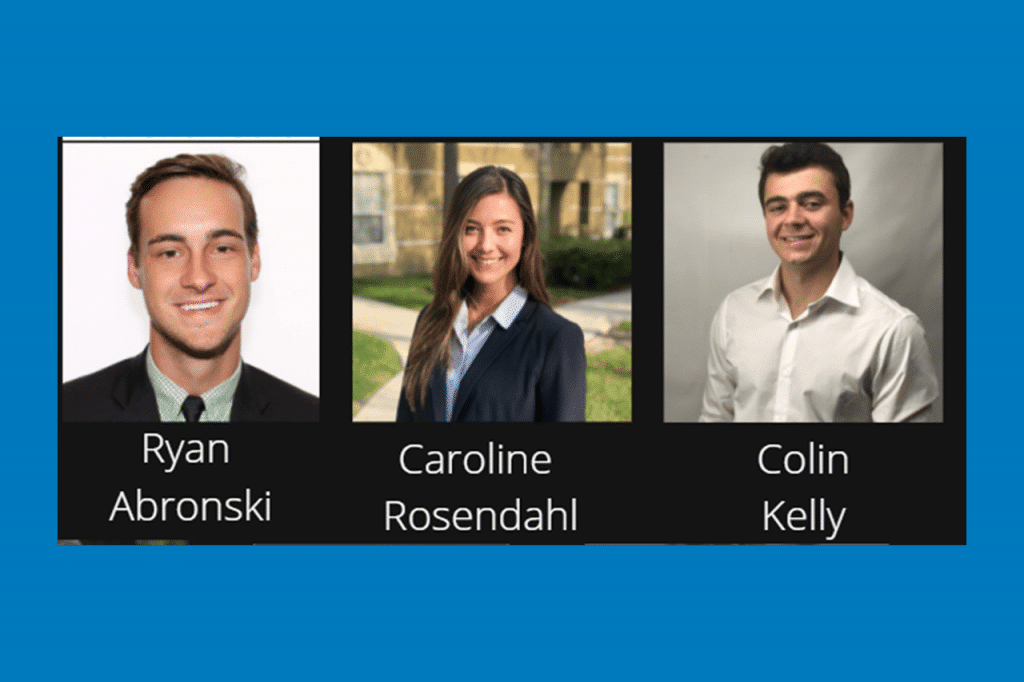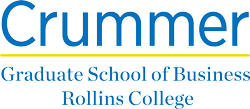Featured Students
Crummer Student Entrepreneur Team Launches Company from Capstone Project

A class project became a business venture for Crummer Early Advantage MBA students and Exhalence co-founders Ryan Abronski, Colin Kelly and Caroline Rosendahl.
Enrolled in Crummer’s NASA-backed Integrative Capstone Experience course, the students received exclusive access to NASA’s patent portfolio, tasked with exploring if any of the patents have commercial applicability. The Crummer-NASA partnership dates back to 2012, and award-winning companies like ecoSPEARS have been launched through the course.
At the beginning of the course, Kelly, Abronski and Rosendahl decided since they all have science backgrounds, they would start their search by thinking about patents that could be used in the healthcare industry.
“We each found a patent we thought had potential to be commercialized, but ultimately we were most excited by a nanosensor that Ryan [Abronski] found at the NASA Ames Research Center,” said Kelly, who also serves as the co-founder of Exhalence.
The nanosensor technology Abronski discovered was originally built to detect and diagnose respiratory diseases, like lung cancer or cystic fibrosis.
“At first, there was a lot of iteration as we thought about how powerful this NASA patent was,” said Abronski.
Throughout the duration of the Integrative Capstone Experience, the student team pitched the technology as a “cure-all” that can detect cancers and a multitude of diseases.
Although the semester was winding to a close, the student team decided that the end of the course would not be the end of the road for this intriguing project.
Crummer’s entrepreneur-in-residence Dr. Pete McAlindon gave the team his full support as they transitioned their focus from a class project to launching a real company.
“Dr. Pete is like our partner always watching over our shoulder,” said Abronski. “He does a great job making you feel supported, while also being hands-off enough to let us fend for ourselves as entrepreneurs.”
Launching Exhalence
The first big decision the Exhalence team needed to make was finding a target market to focus on.
Pitching Exhalence as a “cure-all” sounded great at first, but they quickly realized it wasn’t a realistic route to go. While the original patent was built for detecting and diagnosing diseases, the team received guidance that leaving the liability to the consumer would be wise.
“Having us responsible for diagnosing someone would be a lot of weight on our shoulders,” said Rosendahl. “We were suggested to look at something that can be lifestyle-ized.”
They started researching possible target markets when they came across the diabetes market, noticing that 34.2 Americans have either Type I or Type II diabetes, and another 88 million Americans have prediabetes. Overall, it is one of the largest healthcare markets out there.
Diabetes is managed by the constant monitoring of blood glucose, which is measured via a prick to the finger or attaching a sensor into their skin.
Often an uncomfortable experience for diabetics to constantly prick their fingers or have a device attached to their arms, the Exhalence team realized the nanosensor technology uses a breathalyzer that is able detect blood glucose.
It was their “voila moment.”
“We are making a glucose monitor unlike any in the market currently,” said Kelly.
“That’s where the name Exhalence came from,” said Kelly. “We are making a breathalyzer that will give you the same measurement for blood glucose through the breath, without pricking your finger or injecting a sensor.”
Excited and motivated, the team decided to reach out to the Rollins’ Social Impact Hub to see if they could start to build up seed funding to pursue this idea further.
They were encouraged to sign up for the Ideas for Good Pitch Competition, where teams submit innovative solutions to social challenges to win seed funding and mentorship. The team placed 2nd, winning $1,000 and more importantly, building confidence that this was an idea that had legs.
“That motivated us to continue to pursue this project,” said Rosendahl.
Their next step was the Crummer Rollins Venture Plan Competition, the largest and most comprehensive pitch competition in Central Florida, hosted by Crummer’s Center for Advanced Entrepreneurship.
Despite being only a couple of months old, Exhalence was one of 16 teams selected out of 48 applicants to move onto the semifinals of the Venture Plan Competition.
The Venture Plan Competition forced the team to lay out detailed strategic visions, milestones, and narrow their pitch deck down to a concise, easily-palatable presentation.
“That was something we hadn’t done yet, getting very specific about our goals, challenges, and timeline,” said Kelly.
Next Steps
With graduation on the horizon for the Exhalence team in May, they are setting weekly goals, with the next big milestone being a prototype.
“After that, it’s developing clinical partnership talks with local stakeholders,” said Abronski. “Then we can begin testing. I think it’s in the near future.”
The Ideas for Good competition and Venture Plan Competition also made the team look inwards, identifying their strengths and weaknesses.
With three soon-to-be MBA graduates on the core team, they are confident on the business side of things. Crummer and Rollins connections have allowed them to gain mentorship from local leaders and advisors. The area they most need help with is on the technology side.
“We have the business side of things covered, but we could really use a member of the team who is an expert on the technology,” said Kelly.
As business leaders who want to impact their community in a positive way, they want Exhalence to be viewed as not just a business opportunity, but a transformative medical tool that helps create a more equitable healthcare system for those suffering from diabetes.
“We want to focus on serving the underserved; we hope to build the trust of the diabetes community and make a real positive impact in the diabetes market overall by pushing for equal access to healthcare,” said Abronski.

